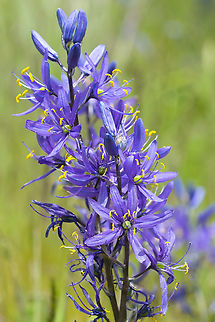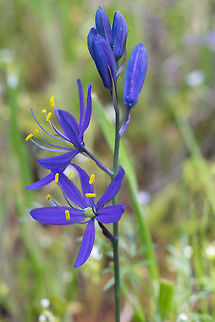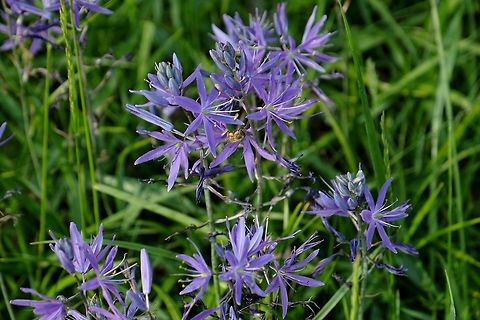
Naming
The genus name comes from the Nez Perce Indian name for this plant, and means "sweet". "Qém’es", a term for the plant's bulb, which was gathered and used as a food source by tribes in the Pacific Northwest, and were an important food source for the Lewis and Clark Expedition. The bulbs were harvested and pit-roasted or boiled by women of the Nez Perce, Cree, and Blackfoot tribes.
Distribution
Though the once-immense spreads of camas lands have diminished because of modern developments and agriculture, numerous camas prairies and marshes may still be seen today. In the Great Basin, expanded settlement by whites accompanied by turning cattle and hogs onto camas prairies greatly diminished food available to native tribes and increased tension between Native Americans and settlers and travelers. Both the Bannock and Nez Perce Wars began after Nez Perce became incensed at the failure of the US government to uphold treaties, and at settlers who plowed up their camas prairies, which they depended on for subsistence.
Habitat
Though the once-immense spreads of camas lands have diminished because of modern developments and agriculture, numerous camas prairies and marshes may still be seen today. In the Great Basin, expanded settlement by whites accompanied by turning cattle and hogs onto camas prairies greatly diminished food available to native tribes and increased tension between Native Americans and settlers and travelers. Both the Bannock and Nez Perce Wars began after Nez Perce became incensed at the failure of the US government to uphold treaties, and at settlers who plowed up their camas prairies, which they depended on for subsistence.Food
While the bulbs of "Camassia" species are edible and nutritious, the white-flowered meadow death-camas is toxic, and the bulbs are difficult to distinguish.Camas has been a food source for many native peoples in the western United States and Canada. After being harvested in the autumn, once the flowers have withered, the bulbs are pit-roasted or boiled. A pit-cooked camas bulb looks and tastes something like baked sweet potato, but sweeter, and with more crystalline fibers due to the presence of inulin in the bulbs. People have also dried the bulbs to then be pounded into flour. Native American tribes who ate camas include the Nez Perce, Cree, Coast Salish, Lummi, and Blackfoot tribes, among many others. Camas bulbs contributed to the survival of members of the expedition of Lewis and Clark.
Uses
Camas is not just an edible plant, it is also grown as an ornamental plant. Even in the wild, large numbers of camas can color an entire meadow blue-violet.References:
Some text fragments are auto parsed from Wikipedia.